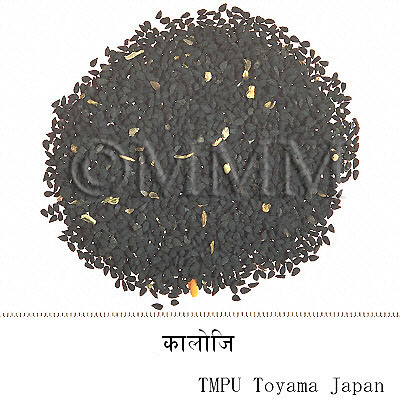Crude drug sample data base
※Click on the image to enlarge it.
Crude drug name | Market name | Kalonji |
|---|---|---|
| Formal name | Upakuncika | |
Other names Tips! | Kalonji, Kalajira (T), Kalijira (B), Kalonji, Kalajira (H), Kalijirige (K), Karimjirakam (M), Nullajilakara (Te), Karunjirakam (Ta), Kaljira, Mugrelo (N), Kaluduru (Sin) | |
| English name | Small Fennel, Black Cumin | |
| Original plant name | Nigella sativa Linn., Small Fennel, Black Cumin | |
| Family name | Ranunculaceae | |
| Used part | Classification | Plant origin | Sub classification | seed |
| Collection information | India, New Delhi | |
| Collection date | 1991/05/07 | |
| Collector | Tsuneo Namba, et al. | |
| TMPW No. | 12519 | |
The capital city, provincial capital city or the representative
location of its administrative area is indicated.
location of its administrative area is indicated.
Production area information
https://ethmed.toyama-wakan.net/img/pin_san.png
28.6139391
77.20902120000005
Collection information
India,New Delhi
https://ethmed.toyama-wakan.net/img/pin_nyu.png
Scientific information data base
| Crude drug name | Ayurvedic name or Sanskrit name, English name | Upakuncika, Small Fennel, Black Cumin | ||||
|---|---|---|---|---|---|---|
| Synonyms | Ajaji, Kuncika, Kala, Prtthvika, Udgarasodhini, Susavi, Karavi, Kalajaji, Upakuncika, Kalika, Upakalika, Prtthvi, Prthukrsna, Upakunci, Kunci, Brhajiraka, Dipya, Sthulakana, Manojna, Jarani, Jirna, Taruni, Sthula jiraka. | |||||
| crude drug image |
| |||||
| Original plant name | Nigella sativa Linn. | |||||
| Family name | Ranunculaceae | |||||
| Used part | Seeds | |||||
| Distribution area | Native of Levant, said to be cultivated or occasionally occurs as a weed of cultivation in Punjab, Himachal Pradesh, Bihar and Assam. | |||||
| Remarks | Common. | |||||
| Common uses | Seeds are stimulant, carminative, diuretic, emmenagogue, galactagogue. They are used in mild cases of puerperal fever. Powdered seeds with sesamum oil are much used as an external application in eruptions of the skin. | |||||
| Therapeutic uses | Raktapitta (bleeding disorders), Sula (colic), Adhmana (abdominal distension), Ajirna (indigestion), Jantu (worms), Vatagulma (intestinal swelling due to Vata), Ama (indigestion) | |||||
| Chemical constituent | Others - Seeds contain essential oil, toxic glucoside melanthin, bitter substances, melanthigenin, nigellimine. - The oil contains carvone (45-60%) d-limonene and cymene; Nigellone compound, fatty oil contains nigellin. | |||||
| Pharmacological effect | Clinical trial indicates possible use of nigellone in cough and bronchial asthma. Ethanolic extract of the seed and volatile oil from the seeds showed anti-spasmodic effect in experimental animals. Seed oil showed anti-bacterial, insecticidal, broncho-dilatory, hypotensive, immuno-stimulant activities. Black cumin along with other plant extracts was found to show anti-cancer activity. It also proved effective in treating oral cancer. The other plants probably had a nullifying effect on the toxic side effects of cumin. Single injection of saline solution equivalent to 160mg/kg body weight of the extract produced no significant effect on the blood glucose, cholesterol, urea creatinine, total protein, albumin as well as liver DNA and RNA levels. Thus, used at dose level, the extract had no harmful side effects. | |||||
| Medical system | Ayurveda (Traditional Indian medicine) | |||||
| Traditional concept | Rasa (Taste) | Tikta (Bitter), Katu (Pungent) | ||||
| Virya (Potency) | Usna (Hot) | |||||
| Guna (Quality) | Laghu (Light), Ruksa (Dry), Tiksna (Sharp) | |||||
| Vipaka (Post digestive taste) | Katu (Pungent) | |||||
| Karma (General action) | Garbhasaya visodhanam (purifying uterus), Agnidipana (increasing digestive fire), Vrsya (aphrodisiac), Medhavardhana (good for intellect) | |||||
| Dosakarma (Action on dosa) | Decreases Kapha, Pitta | |||||
| Traditional usage | 1. Kalajaji (Nigella sativa) taken with jaggery controls irregular fever. 2. In intrinsic haemorrhage/hemorrhage, when metallic smell appears in breath and eructation, the patient should take Prthvika (Nigella sativa) in the dose of 2.5 gm mixed with double sugar. 3. Upakuncika (Nigella sativa) is one of the ingredients in "Takrarista" (a formulation) useful in piles. 4. It is one of the ingredients in "Ksaraguda" (a formulation) beneficial for "Gulma" (intestinal tumours/tumors). 5. Upakuncika participates in the formulation of "Narayana curna", a well-known formulation for ascites. 6. One should take powder Upakuncika, Hing (Ferula assa-foetida), Amlavetasa (Garcinia pedunculata), two types of Brhati (Solanum spp.), Hapusa (Sphaeranthus indicus) and Vaca (Acorus calamus) and also ghee prepared with them. 7. In coryza the powder of Rohisa (Cymbopogon martini), Jiraka (cumin), Vaca, Tarkari (Premna mucronata) and Coraka (Angelica glauca) or Tvak (Cinnamomum zeylanicum), Patra (Cinnamomum tamala), Marica (black pepper), Ela (cardamom) and Upakuncika should be inhaled. 8. The paste of Ela, Devadaru (Cedrus deodara) etc., containing Upakuncika is administered to the woman. 9. Vaca, Upakuncika etc., should be pounded with clear wine and fried with ghee. It should be taken in order to remove pain in female genitals and sides, cardiac disorder, intestinal tumour and piles. 10. One should take Vasa, Matulunga (Citrus medica) root and Madayantika (Lawsonia inermis) with wine added with salt, Pippali (Piper longum) and Upakuncika. | |||||
| Formulation | Takrarista, Ksaraguda, Narayana curna, Kankayana gutika | |||||
| References | Reference book Tips! | [2] Indian Medicinal Plants - A Compendium of 500 species, Varier, P.S., Orient Longman Ltd. Chennai (Madras) Vol. 4 (Repr.1997), pp 139-141. Glossary of Indian Medicinal Plants, 1956. Chopra, R.N., Nayar, S.L. and Chopra, I.C., Council of Scientific & Industrial Research, New Delhi. - New Edition (1996) National Institute Science Communication; Supplement pp 176-177. The Ayurvedic Pharmacopoeia of India, Part I, Vol I, Ed. I, 1989. Govt. of India, Ministry of Health & Family Welfare, Dept. of Health, New Delhi p 119. Plants in Ayurveda (A Compendium of Botanical and Sanskrit Names), 1997. Abdul Kareem, M., Foundation for Revitalisation of Local Health Traditions, Bangalore 1168. Dravyagunavijnana, Vols. 1-5, reprint 1998. Sharma, P.V., Chowkhambha Bharati Academy, Varanasi Vol. 2, pp 596-598. Classical uses of Medicinal Plants, 1996. Sharma, P.V., Chaukhambha Visvabharati, Varanasi p 58. | ||||
| Remarks | Black cumin is one of the constituents of a Siddha preparation Karpogi, a paste used in the treatment of leucoderma. A drug called Attaticcuranam containing black cumin as one of the ingredients is a popular medicine in Siddha as a digestive, appetizer and antirheumatic. Black cumin is one of the ingredients of ‘Majoon-e-fanjosh', a Unani drug used in the treatment of liver ailments, anaemia, ascites, piles, indigestion, spermatorrhoea/spermatorrhea and dropsy. This should not be mistaken with the fruits of Carum carvi L. (Caraway seeds) which are also sometimes known as Kalajira constituting another Ayurvedic drug Krsna jiraka. | |||||
| Last renewal date | 2024/01/10 | |||||




